The Arrow of Time VERSUS The Multitude of Arrows of Time |
|
|
By Creator of Knowledge BoBan |
In this creative article, the pillars of the dialectical understanding of time and space were first presented, and then through the prism of this concept of time and space, the rectilinear understanding of the Arrow of Time was discussed and re-examined. Seen from the perspective of dialectical interactive approach, since thy physical presence (body: individual way of thinking) is surrounded on all sides by the creative results and initiated dia-processes of the past [SPACE IN TIME: matter embedded in the past (HERE and NOW)], the flow of future events in time also depend on the hidden intentionalities of all key actors. In other words, all these hidden intentions and intentionalities are currently still located within Time in Space (NOW and THERE), that is, at this stage of the development of time (of their conceptual project), they are only emotively emotionally present in the outer worlds of Space in Time (HERE and NOW), understood in the sense of the desired future course of events in this dialectical understanding of space and time [future, emotively emotional presence dia physical presence, past].
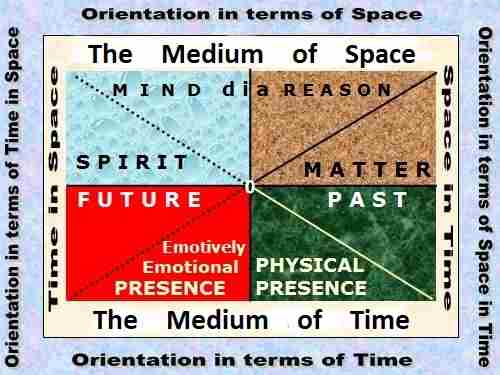
Dialectical Creative Framework for Orientation and Navigation in Time DIA Space expressed through its Two Paired Dialects: Time in Space ⇄ Space in Time DIA Medium of Time ⇄ Medium of Space
It follows from this that there are innumerable such directed arrows (of desire) from Time in Space towards the targeted Space in Time [external dialectical worlds of matter already embedded in the past], because every living being and group community has the right to this emotively emotional "living of the dream life". And whether it will come true or not, depends on countless factors, including the mutual collision and conflict of these (hidden) intentions and intentionalities, as a result of their attempts to carry out these hidden inner intentions into reality, that is, to externalize and embed them in the outer worlds of dialectics (intentionality). Either way, for these stated reasons, the future and its springs for the formation (of river) of time should be sought within the framework of these inner expanses of TIME IN SPACE [the hidden future in the spirit: NOW and THERE], and thus time begins there, while all these (hidden) intentions and intentionalities are realized or not, in the outer worlds of Space in Time (HERE and NOW). Or to put it another way, everything that is perceptible with the five basic senses was previously conceived in these invisible and imperceptible inner worlds of Time in Space (NOW and THERE), and was only then manifested and materialized in outer dialectical worlds of the Space in Time (HERE and NOW). In other words, this "inner" future has been externalized and in that way by bringing to completion its utmost purpose, it was transformed into the past.
introduction: The Arrow of Time VERSUS The Multitude of Arrows of Time
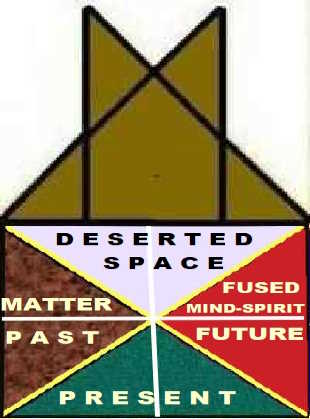
The Hidden Knowledge: Methodological Reasoning DIA Comprehending of the (Recti)linear Space and Time, understood AS SOMETHING OUTSIDE us
How then is it possible to perceive time in terms of its flow from the past to the present to the future, that is, as an arrow of time? First, it is generally speaking the end result of understanding not only space but also time as something outside us in interaction with the consideration of these two mega-dialects separately from each other.
- For this reason, to explain why time itself is irreversible, that is, it can not move backwards, processes in nature (notice, outside us) that also take place in one direction have still been used to explain this phenomenon of the arrow of time. One such analogous concept in physics is that things tend towards entropy, that is, they become more and more chaotic as time passes. It follows from this that if the cosmos is assumed to be a closed system, its entropy (degree of disorder) can never be decreased. In other words, the cosmos cannot return to exactly the same state it was in at an earlier point of development, and for this reason, time cannot move backwards.
- Another explanation is that the natural world follows the laws of thermodynamics. The second law of thermodynamics states that within an isolated system, the entropy of the system remains constant or increases, the result of which is a thermodynamic explanation of the arrow of time. As an example, imagine a gas box in which all the particles were initially placed in one corner (an ordered state). Over time, these gas particles would naturally try to fill the entire box (a disordered state). But if attempts were made to return all these particles to their original ordered state, it would require the expenditure of additional energy. In other words, this reverse process to start on its own is impossible, that is, this original state of the particles in this gas box is irreversible.
In the following chapters, it will be elaborated on why time (dia space) proceeds from these invisible, distant, unexpected, unknown, hidden, inner worlds of Time in Space (NOW and THERE as the future wrapped and hidden in spirit) and then it is manifested in the outer worlds of Space in Time (HERE AND NOW as matter embedded in the past), which completely contradicts the straight line understanding of the arrow of time: past → present → future. Only then in this broader context does it make sense to further creatively consider the concept of The Arrow of Time VERSUS The Multitude of Arrows of Time, as well as other unresolved unknowns regarding this very complex topic. Keep in mind that all previous (scientific) understandings of space and time are based on their (external) physical (material) manifestations, thus supported by appropriate types of (external) observation and measurement. On the other hand, since the dialectical understanding of time and space [spirit, mind dia reason, matter] is based on lost hidden knowledge, not only linguistically but also its pictorially comprehensible dialects for describing, elaborating, explaining these internal, unknown, phantomlike, invisible, hidden dialectical worlds of Time in Space came to light again, as well as an understandable way of communicating, both inside this hidden Time in Space (NOW and THERE) and beyond it with the ubiquitous manifestations of Space in Time (HERE and NOW). Since the rectilinear understanding of space and time in the sense of something outside us is deeply rooted in all dominant languages, in spite of the fact that each redefinition of time and space changes the view of the world, it is impossible to change the syntax and semantics of modern languages, especially among wider layers of people, as well as corresponding deep-rooted ways of thinking.
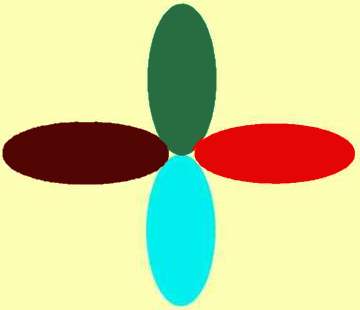
Eternity DIA Infinity, symbolically represented as chained Grummets of the Four Elements
It follows from all this that the ancient way of pictorial representation of the dialectical understanding of eternity (8) and infinity (∞) in the sense of turning and twisting Space in Time around the central axis where it joins Time in Space, as well as the spatial medium (mind dia reason) around the central axis where it touches the medium of time (emotively emotional presence dia physical presence), was not a coincidence. On the contrary, it could be argued that this was a way to pictorially present and conjure up this upside-down way of understanding, expressing, and manifesting time (and space), the consequences of which were creatively considered more deeply and then applied in this creative article. As a final result of this, a graphic pictorial illustration of the dialectical conception of eternity (8) and infinity (∞) was formed around this central axis in miniature, where in fact all these described events take place [because eternity (8) dia infinity (∞) is too large for a dialectical synthesizing such an inexpressible scope of times and spaces]. The distances between these chain links represented in fact different measured deviations of time and space. In addition, these elliptic representations of eternity (8) dia infinity (∞) are even more simplified by their additional transformation into triangles (triangulation).
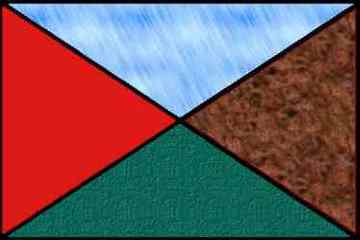
Dialectical Frame for the Encapsulation of Eternity DIA Infinity represented by the Four Ancient Elements in a Temporary State of their Unity
Since this triangular form of representation of eternity and infinity is still unsuitable for mutually comprehensible description, reasoning, and communication with the constituent parts ("dialects") of the rectilinear and linear understanding of time and space, this triangular pictorial representation is further simplified. In short, a working creative framework of a simplified dialectical understanding of eternity and infinity was formed (⊠). The previously mentioned accumulated dialectical deviations of time and space within eternity (8) dia infinity (∞) were annulled and ignored, in such a way that the rectangle or square is diagonally cut by a crosswise in four triangles (dialects) due to the previously mentioned easier mutual rectilinear communication and interpretation of these two different conceptions of time "AND - DIA" space, in which the four primary elements were then placed: fire, earth, air, water. For additional information regarding the creation and development of the Dialectical Creative Framework for Orientation in the Eternity of Time DIA Infinity of Space, read: Dialectical Creative Framework.
The Arrow of Time VERSUS The Multitude of Arrows of Time
Although at first glance, within the mob and group medium of time (PRESENT), acquired without a deeper insight into this very complex dialectical, interactively creative content, time seems to follow a linear (circular ○ or elliptical) path of time (wheel of time), or rectilinear path of time (river of time), that is, past ⇢ present ⇢ future (arrow of time), it is not so in dialectical (changeable) reality, because this isolated, one-sided understanding of time ("river of time or wheel of time"), as the end result of the ruling dual (AND - AND) ⇢ bipolar (or - or) way of thinking DIA binary (or) way of thinking, completely ignores the fact that any separate consideration of the mega-dialects of time and space, as well as their component dialects, cannot be used to create dogmatic convictions, a kind of collective hypnosis. Especially not, for the creation of such dogmas that are derived from inadequate or superficial use of the five basic senses (beyond their useful range). Anyway, this widespread interpretation of the arrow of time is disputable, both from the standpoint of valid empirical evidence versus the understanding of space and time separated from each other as something outside of us and from the viewpoint of the methodological settings and assumptions of the dialectical interactive approach.
In other words, the real essence of these two mega-dialects is in their interplay, interaction, and mutual cooperation, which will be discussed in more detail in the next chapter. Considered from the point of view of this methodological approach (dialectical interactive approach), the essence of each considered dialectical content is not in its thesis (time), nor in its antithesis (space), and for this reason, it is not in their synthesis either (time ↔ space ), but in their all-comprehensive renewed thesis of the considered and re-examined creative content (the essence of what was said until then), which in this dialectical understanding of time and space is derived from the final creative outcome of the dialectical interplay of their four key concepts (interactively creative key-dialects): Time in Space ⇄ Space in Time ⊠ Medium of Time ⇄ Medium of Space [Renewed Thesis, preferably at a higher level of dialectical understanding of time and space].
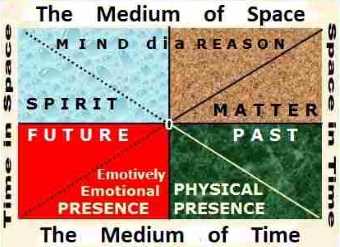
Abstract Methodological Creative Framework of the Dialectical Interactive Approach: Four Key Concepts of the Dialectical Understanding of Time and Space, expressed through its Two Paired Dialects: Time in Space ⇄ Space in Time DIA Medium of Time ⇄ Medium of Space
As a result of all the above, one could challenge all supporters of this rectilinear understanding of time with the argument that their observation of the passage of time (with the five basic senses) within the external worlds of Space in Time in the form of a rectilinear arrow of time (→) is far better represented by following its flow from the past to the present (←), and then refract (↵) and return it back to the future. As a result of this approach, something that appears (Space in Time) to one actor of this dialectical interplay of time and space as the present (NOW and HERE), for example, now and here on the big stage I sing a song from the depths of my soul, to another the same this looks like the past within their separated Medium of Time and Medium of Space, and as a result, a different observation and understanding of the flow of time and space results. In other words, the real NOW (in THERE) is within each of them [the own Time in Space, that is, where the future springs and begins], and not out of them: the sequence of happenings and the tracking of events in (Space in) Time because here the words goes about the time-line of events in the external material (physical) space. Seen from this redefined rectilinear point of view, within the outer Space in Time (matter embedded in the past) the present originates from the past, that is, more precisely, it is bounced off some form and manifestation of matter embedded in the past, returning transformed to its previous 'original' state: the future [in spirit, that is, in its own inner Time in Space].
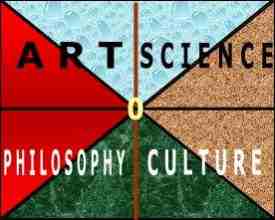
The Background Simulation Settings of the Dialectic Interactive Approach
After all, the sense of sight also functions in this previously described rectilinear way, which in fact is only able to react to the bouncing off (← reflection of) light (⇄), while the first original path of the light ray (→) is beyond the reach of the sense of sight. Since the way of thinking of most people is based on physical facts observable with their five senses, "what I see is what I believe" in this particular case, then it is not a big surprise that the interpretation of events around them through the too narrow prism of their five senses is so deeply engraved in their consciousness and subconsciousness. In short, these five basic senses have always played a dominant role in shaping their views of the world around them. Thus, for example, despite the above-mentioned shortcomings of the sense of sight far-reaching, and the conclusions drawn on this basis, this played a decisive role during the formation of this generally accepted arrow of time (past ⇢ present ⇢ future), by not noticing the original arrow of the light ray (future → "present " → past), which is replaced by simply turning the arrow of the reflected light beam (future ← "present" ← past).
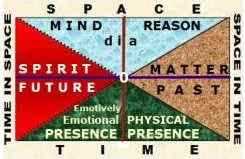
Dialectical Creative Framework for Orientation in the Eternity of Times DIA Infinity of Spaces
The previously explained understanding of the arrow of time (⇢) is also confirmed by the correct interpretation of Einstein's understanding of physical space and time ("Space in Time"). In short, as measured and expressed by the speed of light, wherever thou look (around, above, below thee: thy physical presence) from (HERE within) thy NOW, creative outcomes [where thou art already emotively emotionally present], which have already taken place in the past (and not in the future) are noticed, that is, to be more precise, the external matter incorporated in the past (HERE and NOW) is noticed with the five basic senses. For this reason, surrounded on all sides by the recognizable (external) face of the (matter embedded in) past, which is perceptible and felt by the five basic senses, the only way out of this (trapped) physical Space in Time is invisible reflexive and reflective redirection of this apparent arrow of time back to the real inner source of this factual state [of the phenomenon or paradox of the dialectical interplay of Time in Space with Space in Time within the dialectical medium of time and space]. In other words, the movement direction of this supposed rectilinear arrow of time is changed, refracting and redirecting it (↵) into the endless expanses of inner Time in Space [the wrapped and hidden future in the spirit] using its dialectical medium of time and space. And then instead of an outward seeming and illusory movement into some kind of external future [deceiving thyself, for example, by not having or nurturing thy own inner expanses], thou in reality reflexively break this imaginative line to intuitively reorient and return to thy inner worlds of Time in Space, where it all began, to confirm that physical fact there that thou saw and noticed with thy five senses in outer worlds of dialectics (Space in Time).

Dialectical Creative Framework for Orientation in the Eternity of Times DIA Infinity of Spaces reflected through the Prism of Dialectical Medium of Time and Space
If you look carefully at the Dialectical Creative Working Framework for Orientation in the Eternity of Time DIA Infinity of Space, you will notice that neither the path of space nor the direction of the flow of time is shown as a straight line (the arrow of time), but these lines are broken and redirected at its four ends (corners), in order to join together forming countless smaller and smaller rectangles (building blocks) of this imaginary pyramid of dialectical understanding the time and space. As a result of this pictorial representation, the future and the past are experienced in the medium of time and space as something behind the corner of this pyramid, or this rectangle, if you see this picture in that way, and not as a straight line in the sense of the arrow of time (past ⇢ present ⇢ future). I hope it is now easier to understand why in the dialectical understanding of time, the future is listed as the initial dialect and not the past, and why the constituent dialects of time are not arranged in a straight line, but are simply separated from each other using a comma, although it could be graphically depicted as future └── emotively emotional presence dia physical presence (Medium of Time) ──┘ past, where future and past are pictorially presented as something behind corners of this dialectical pyramid of mega-time and mega-space.
Simplified for the sake of easier comparison, and then expressed from the point of view of the rectilinear understanding of time (and space), in the dialectical understanding of time (and space), the future spiritually originates in the invisible Time in Space (NOW and THERE), and then this idea, after its transition, that is, transmission from the subconscious to the conscious, is further elaborated and transformed in this dialectical medium of time and space until it is somehow physically manifested, realized, and transformed into some form of manifestation of Space in Time (HERE and NOW). From this it follows that within these outer worlds of Space in Time (matter embedded in the past), time manifests as the measurement of perceived dialectical changes (... from second to second, from minute to minute, from hour to hour, from day to day ...), as well as for registering the sequence of events with the five basic senses in this outer Space in Time [⇢ forward arrowed line = chronological time-line of events and resulting events in (this outer Space in) Time]. Finally, it is very important to note that the dialectical understanding of time and space is not presented linearly but pictorially following the mutual interaction of its four key concept-dialects in accordance with the unfolding of the three basic dialectical principles, aspects, properties and the manifestation of dialectics within these vast star-like expanses.
Five Basic Senses: Trouble Makers or a Useful Aid for Proper Orientation and Navigation in Time and Space

Dialectical Creative Framework for Orientation in the Eternity of Times DIA Infinity of Spaces
Pay special attention to this interactive cooperation between thy physical presence within the (jurisdictional boundaries) of Space in Time (HERE and NOW), which can also be observed with the five basic senses, and the invisible emotively emotional presence within the various manifestations of Time in Space (NOW and THERE), which can only be sensed intuitively, as well as felt with two (additional) human senses [the sense of intuition and the sense of inner feeling of self], in a dialectical interplay with the corresponding spatial medium (mind dia reason). Notice also that in this narrower context of Space in Time, thy five basic senses are just one very useful aid for easier orientation and navigation in the external world that surrounds thee, as well as for thou to more easily deal with the problems and challenges that arise within it, understood in terms of their useful (common senses') scope and reach. It also follows from this that excessive reliance on these five senses, without proper processing and interpretation of these sensory observations in the dialectical medium of space and time, also contributed to the emergence of the concept of the arrow of time, which begins in the past (and not in the future).
In other words, the embedded matter in the past (Space in Time) is present wherever thou look, whatever you hear, whatever you smell, touch, taste. Reconsidering this subject under creative consideration from the perspective of the crowd and group way of thinking, despite the fact that your casted glance has its source in your sense of sight, and from there it follows a path towards the desired goal [⇢ some manifestation of embedded matter in the past], and from where it is then bounced off, that is, reflected and redirected back (←) to its source, this will not prevent most people from simplifying this apparently two-way forward-backward (⇄) movement, as well as to reverse the direction of the movement of the arrow of time by reducing it to an one-way direction of the unfolding of events (present ← past), which is in complete agreement with their indispensable binary way of thinking, because the first (original) time arrow (⇢) remained unperceived and unnoticed, and therefore dropped and forgotten.
But this is not the end of this typical two-polar binary story, which is in full accordance with the concept of the functioning of the simple mind and reason. Summarizing everything previously said, this does not prevent them from turning this backward movement (present ← past) into a forward movement, and to present in their mind this mental gymnastics and acrobatics as the unfolding and movement of events from the direction of the past to the present, that is, to redirect, and graphically illustrate the arrow of time as past ⇢ present ⇢ future. Now the question naturally arises, who can dispute this or claim that the flow of time cannot be diverted in any direction? In other words, after these demonstrated skills of mental acrobatics, it is no surprise to see the possibility of moving forward again in a straight line towards some fictitious future within these external material worlds where the absolute ruler is still (matter already embedded in) the past. By the way, it has been noted that quantitative equations in the field of (particle) physics work equally well regardless of whether time moves forward into the future (rectilinear understanding of time) or backward into the past ("dialectical understanding of time"). In spite of this, it is generally accepted that time in natural worlds follows only one direction [arrow of time: past ⇢ present ⇢ future], which is no surprise considering how the prevailing way of thinking is formed within the mob and group way of understanding the present as a universal medium of time as opposed to an individual dialectical medium of time (emotively emotional presence dia physical presence ).
As it was demonstrated in the previous chapters of this creative article, here again the abstract concept of mega-time and mega-space is confused with concrete manifestations of their constituent dialects in the worlds of dialectics, that is, in the worlds of nature. Although even in Einstein's understanding of space and time, considering these concepts separately from each other has no sense and significance, it is still neglected and overlooked, just as the methodological straight-line relationship between cause and effect is also neglected (Cause → Effect). In the outer concrete, physical sense, this is expressed as an irreversible transformation and metamorphosis of inner Time in Space (Cause) into outer Space in Time (Effect), that is, as an irreversible transition with a short flash of a hidden and cocooned Future in Spirit (NOW and THERE) into some form of perceivable physical manifestation of Matter embedded in the Past (HERE and NOW). It follows from this that the concept of the arrow of time was not aligned with these latest concepts of time and space, both in terms of substance and methodology, that is, it remained incomplete, sketchy and methodologically inconsistent. All of this previously explained and elaborated is deeply rooted in all dominant languages, which are based on a rectilinear conception of space and time in terms of something outside of us in interaction with the consideration of these two mega-dialects separately from each other.
- If the content of a typical sentence related to a (planned) future activity is considered more deeply and analyzed, for example, "I'm going to Manchester next week to visit my daughter and grandchildren.", it is noticeable that the prerequisite for the realization of this inner desire or intention of thys is assumed or omitted again (conditional). In other words, the full sentence would read: "If I'm alive and well, or if nothing unforeseen happens, I'll be going to Manchester next week to visit my daughter and grandchildren." It clearly follows from this that this inner desire, intention or plan of thys, that is, the chronologically planned event in the external calendar, will come true only if this precondition (conditional) is fulfilled.
- It could also be said that thou art actually waiting for this day (the date in the external calendar) rather than moving along this imaginary line of outer (space and) time. In any case, seen and considered from thy individual perspective, thou art not following this arrow of time regarding this external future event. On the contrary, this external impersonal observation, perception, and chronological registration of the sequence of events (timeline) in the sense of this rectilinear arrow of time (past → present → future) is the end result of the mob and group way of understanding the rectilinear time (and space) as something outside of us in interaction with the consideration of these two mega- dialects separately from each other. In other words, this external, impersonal perception and chronological registration of the sequence of events using some form of manifestation of a real or fictitious external calendar in the sense of following this rectilinear arrow of time (past → present → future) will continue with or without thee within it, that is, regardless of whether this inner desire, intention or plan of thys will be realized or not.
- In the meantime, thou will continue with thy usual activities, or with solving unplanned and unforeseen scenarios and situations in this dialectical understanding of time and space, where thy every activity [dialectical arrow of time (and space)] is dependent on the previously mentioned precondition (conditional). For example, thou will go to work, thou will go with thy wife to the cinema, a restaurant, visit a sports, artistic or cultural event and manifestation, and the like. In short, until the pre-planned day of thy visit arrives, thou can only be emotively and emotionally present with thy daughter and grandchildren within thy dialectical medium of space and time, or in a virtual sense using the available means of communication with them. In other words, only when that desired day in this external calendar arrives, thou will head towards the desired destination (Manchester), that is, move dialectically in space and time until this previously planned inner desire or intention of thys is realized, accordingly with it, until thou don't meet (in the physical sense) thy loved ones, either at the airport, pier, bus or train station or in their family home.
- It follows from all the above that only when this gap between your emotively emotional presence in your spatial medium (mind dia reason) and your separating physical presences disappears, this inner intention of thys and (your common) desire is finally fulfilled. Or to put it another way, this inner future of thys [hidden and wrapped in the spirit, that is, manifested in the spiritual sense] has completed its mission by the external act of its transition and transformation into (matter embedded in the physical sense in) the past. In other words, this hidden inner Time in Space (NOW and THERE) is transformed into outer Space in Time (HERE and NOW), which is also visible and perceptible with the five basic senses.
This creator of knowledge hopes to have succeeded in presenting, picturing, and conjuring up the fact that one-sided seeing or searching for the future in these outer expanses of the rule of (matter embedded in) the past is illusory and self-deluding [especially seen from an individual point of view of this complex concept under creative consideration]. Rather, it could be said that this is a smaller or larger short-lived (but also powerful) flash of the inner and until then hidden future (in the spiritual sense) in these outer expanses of Space in Time, although sometimes it has the force of a Super Nova.
- As an example, just try to imagine this outpouring of feelings and appropriate emotions during this meeting and union of the members of this extended family, which was under creative consideration, understood in terms of this interactively creative interplay of Time in Space with Space in Time within (their common) dialectical medium of time and space.
Moreover, it could be added to this that their individual dialectical arrows of time and corresponding space are actually only now being directed and united to the greatest possible extent, understood in the sense of their joint participation and action within this (limited) Space in Time, by harmonizing their individual dialectical arrows with the flows of this external arrow of spending time together (shared time DIA corresponding space), that is, with the currents of this external representation of the passage of time in terms of this imaginary line in the considered space. Recapitulating this very complex dialectical content that has been creatively considered and re-examined related to the rectilinear understanding of the arrow of time [mob and group way of thinking] versus its many dialectical manifestations [individual or singular way of thinking and deliberations], even mudslides on the road, landslides, earthquakes and other natural calamities and catastrophes [Space in Time: HERE and NOW] are the result of (long-term) preparation and creation of preconditions and conditions for their external manifestation [hidden Time in Space: NOW and THERE].
Seen from the perspective of the dialectical understanding of time and space, when the hidden and imperceptible intentions and intentionalities of the actors of Time in Space (NOW and THERE) are outwardly manifested and physically realized HERE and NOW (Space in Time: matter embedded in the past), then this dialectical process (of changes, not rectilinear or linear movement in time OR space) is irreversible, because both time and space are fused, integrated and permeated with each other by the concrete manifestation of their constituent dialects.
- I hope that it is now easier to understand why the rectilinear relationship between Cause and Effect is irreversible in life-reality, because due to mutual interpenetration, a dialectical change of the state of the constituent dialects of time and space occurred, and not within time or within the considered space. In other words, it is now much clearer why cracking an egg to make an omelet, as soon as it spreads and fills the heated frying pan is an irreversible dia-process, that is, it will never return to being egg-shaped again (with the original shell).
Or expressed in another way, this physical (material) event and manifestation of the constituent dialects of time and space is engraved in the memory of this dialectical understanding of time and space. Moreover, the deeply etched emotively emotional events in the dialectical understanding of time and space cannot be erased so easily. In other words, although this is an irreversible outcome in Space in Time, it does not mean that what was deleted, lost or forgotten cannot be revived later (Time in Space), in a more or less authentic form of manifestation of something already taken place in this dialectical understanding of time and space. The reviving of this ancient methodological approach (dialectical interactive approach), as well as the dialectical understanding of time and space, as important contents and pillars of lost hidden knowledge, from the inner Time in Space (future wrapped and hidden in spirit), is in support of that. For further information, read, Retrospective Recollection: Dialectical Understanding of the Spiritual DIA Mindual Intelligence
- I hope that reading this cluster of creative articles devoted to the concept of retrospective recollection will make you easier to understand, why Space in Time (Effect) cannot physically be returned or re-transformed into Time in Space (Cause), that is, until some way is found to reconstruct the original state of Time in Space, as it happens, for example, after the biological death of a living being by separating its (spiritual) inner being from the (physical) dead body (Space in Time). But also in this case, since there have been dia-changes in the inner being (hidden Time in Space), either in a positive or negative sense, even if all the key actors of his previous life would return to this life (creative) scene, his life course would not be entirely identical to the previous one, but rather would follow a similar life destiny or (evil) fate, depending on the resulting dia-changes in the inner beings of all the key actors of this new assigned life session.
- I also hope that it is now easier to understand why it is impossible to travel (backwards) through the past in the physical sense (of a living body, while remaining alive), because here too the main message of hidden knowledge is valid regarding the dialectical understanding of time and space: In time dia space as a copy or model of eternity of times DIA the infinity of spaces is the only possible life journey in terms of moving forward through the continual transformation of internal Time in Space (Cause) into outer Space in Time (Effect or Consequence), and not vice versa, especially in the sense of understanding not only space but also time exclusively as something outside of us in conjunction with the consideration of these two mega-dialects separately from each other. This continuous transformation of inner Time in Space (Cause) into outer Space in Time (Consequence) is experienced and observed by the five basic senses not as a temporal sequence of events (timeline) but as a movement in terms of the external arrow of time: past → present → future.
- I also hope that it is now easier to understand why time spent or wasted is irreversible, that is, it cannot be moved backwards. In other words, you can't take the past back, but you can use what you've experienced and learned to move forward through this dialectical understanding of time and space by drawing the appropriate lessons.
Creating knowledge and verifying it in a rectilinear understanding of space and time through the narrow prism of the five basic scientific senses
It should also be emphasized here that this modernized understanding of the role of science is very rigid, even ruthless, precisely because of the overemphasized role played by the five basic ('scientific') senses. For example, even though thou kiss (taste), hug (touch), look eye to eye thy wife, girlfriend, body to body ... modern science will still claim that there is an invisible distance of xx.xxxxx nano seconds between the two of you measured by the speed of light. For example, because you have eye sockets, over-sized noses, and the like. As a creator of knowledge who considers every dialectical content from the angles or triangles of the huge creative interactive stage of culture, art, philosophy, and science, I can only imagine how difficult it is to act creatively, and especially to create something in such a rigid and inflexible environment. After everything previously stated, it seems that wherever and whenever the role of the five basic senses in the field of science (and culture and religion) was overemphasized, this resulted in the emergence of (the greatest) absolute dogmas that took centuries or thousands of years to finally collapse, with huge victims and other collateral damage caused to humanity.
As an example, let's take the multi-thousand-year-old dogma that the earth is a flat plate, because if the earth is a round ball (sphere), then how can living beings stand upright on it without holding on to something!? You can't even hang on the ceiling forever; were just some of their arguments. What can be said about the geocentric dogma of Aristotle and Ptolemy, according to which the earth is in the center not only of the solar system, but also of the universe, and that everything revolves around it? It could also be added that the overemphasized role of these five scientific senses has made a significant contribution to the emergence and maintenance of the dual (AND - AND) ⇢ bipolar (or - or) dia binary (or) way of thinking, especially the excessively "scientific" use of the sense of sight: I don't see OR I see ⇢ I don't see = I don't believe. I hope it is now easier to understand why this creator of knowledge in his creative articles so uncompromisingly criticized this bipolar, "logical", and inhuman way of thinking, as well as this inadequate use of the five basic senses in the field of science, modernized in this modern way.
In any case, every such dogma led to the establishment of various 'inquisition courts' and the persecution of dissenters, that is, led to degeneration, stagnation or to the slowing down of technological development and progress of the created civilization, as well as to stagnation in spiritual, mental and rational development, and in this way to various forms of manifestation of the corresponding backwardness, vulgarization, and degeneration of its inhabitants. In fact, it could be argued that different ways of orientation and navigation in time and space, with insurmountably different ways of distinguishing good from evil, and different ways of thinking based on this foundation, including this different view of the role of the five senses with (complete) neglect of two additional human senses, lead to different views of the world that surrounds us, and especially of the worlds inside me ⇄ thee ⇄ us, and thus to the inevitable disputes and conflicts five-sense- and seven-sense beings. In short, seven-sense human beings far better dialectically summarize and synthesize (complex) dialectical contents, noting thereby the small details imprinted in the memory of this dialectical understanding of time and space [spirit, mind dia reason, matter], including reading unexpressed thoughts and dilemmas in the outer Space in Time, which will be demonstrated in the next creative article.
As a conclusion, the rectilinear or chronologically ordered historical understanding of time, which constantly re-sorts (experienced) events in the medium of space and time in the sense of this external, generally accepted arrow of time, in fact reflects the transience of life, societies and civilizations, as well as all manifestations of embedded matter into the past (HERE and NOW). In short, everything else that was not noticed or registered by the five basic senses is relearned, or retrospectively remembered, recalled, and reminded. Then it follows the re-sorting of these experienced, known, learned, and remembered events and happenings, chronologically arranging and classifying them in accordance with this mentally formed arrow of time within these external (material) worlds of dialectics [time-line of happenings and corresponding key events], and which are always in a state of constant (dialectical) changes. I hope that you have been able to recognize here this historical and chronological way of the manifestation of the arrow of time.
Is Time Reality or Another Form of Self-Deception?
The previously explained confusion of the dialectical arrow of time with the time-line of happenings and observed events in the external worlds of the dialectic [the inverted rectilinear arrow of time] has led to the understanding of time as an illusion forged or invented in "our" mind. Despite the existence of this understanding of time as a human delusion, in the dialectical understanding of time and space, time in mutual cooperation with space is an essential property of the universe, without which the universe could not only be created, but also the Grandiose Plan of its Creator, which the universe follows, could not function. Moreover, in a broader, deeper, and further sense, these two mega-dialects through the dialectical interplay of their constituent dialects organized into their four key concepts actually supervise the functioning of initiated dia-processes, both desirable and undesirable, including (partial) renewal of inflicted (collateral) damage. This is achieved using countless symbolic combinations of paired dialects that are formed from the four ancient elements within this also star-shaped creative framework of the applied methodological approach (dialectical interactive approach).
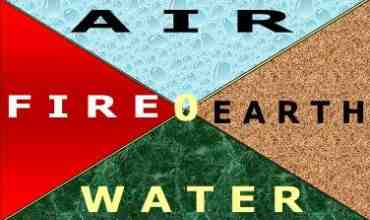
SECRETS OF THE FOUR ELEMENTS: The Unity and Struggle of Dialectical Contradictions in Time DIA Space
DIA
The Four Primary DIA Proto Paradigmatic Presumptions of the Dialectical Interactive Approach
In other words, the interactively creative dialects of this star-shaped methodological universe (Time in Space: NOW and THERE), which work secretly, both behind and inside and outside this magnificently designed master plan of action of the four elements (fire, earth, water, air), located within the numerous layers of this pyramid of time and space, provide an adequate response to any desirable or undesirable activity, including unforeseen activities and actions within this macro-universe (Space in Time: HERE and NOW). Each conceptual project of its creator, including this magnificent master-plan of action of the four elements within the vacuum ("the fifth element") reflects the vision conceived by its creator, which in fact represents a framework conceptual project of interconnected activities.
For all these reasons mentioned above, in this dialectical understanding of the key role of the interactive creative action of time and space, which is based on hidden knowledge, these two mega-dialects need and complement each other so that their more suitable dialects are embedded and cocooned in each other in the appropriate form. In other words, they wrapped themselves in a protective shell or cocoon to later at the right moment physically transform into some form of manifestation of Space in Time (matter embedded in the past). Thus for example within Time in Space: NOW and THERE), every manifestation of mind dia reason including this ruling majestic mind dia reason, wraps using the dialect - spirit around the hidden dialect - future (within it) with the purpose of encapsulating and keeping in this protective cocoon the conceptual plan of intentions and intentionalities of their creator. This is actually a type of timed potentially "explosive rocket", wrapped and hidden within Time in Space (the future hidden in the spirit). In short, it is talked about one pointed arrow of the cocooned hidden future (inside the spirit), which is waiting to be catapulted or fired at the right time from these still invisible inner spaces, causing bigger or smaller bangs in this outer material Space in Time (HERE and NOW), if nothing else, to break the resulting monotony in it.
The timeliness of initiating this elaborated conceptual project within the dialectical medium of time and space also depends on finely elaborated and adjusted (seven-) sensory receivers and transmitters of collected, processed, and interpreted information in this key dialectical medium of time and space. As one example of the action in reality of this Magnificent God's Mega-Plan, for example, its countless explosions in this outer material Space in Time, go to nature during early spring, and listen to these wonderful explosions of previously timed "bombs and rockets" of this type of dialectical arrows of the hidden Time in Space in action. Those with access to (powerful) telescopes can also enjoy similar bigger bangs that play out from time to time in the infinite depths of the visible universe, including illusory, ghostly, long-ago, or unattainable bangs within this form of manifestation of Time in Space (NOW and THERE) in the Cosmos.
As a result of this fantastically designed mega-plan, this Supreme Creator has no need to constantly monitor the course of events in this universe of His, nor to constantly intervene and change the sequence of events within this magnificent creation of His, but rather from time to time: here and there. In addition, unlike these always modern and increasingly modernized "cosmologists and princes of the Earth from ancient times" who care about the well-being of their inhabitants, are busy continuously inventing ways to make them ideal and fully automated robots, it seems that this Magnificent Creator, while devising and working out His Mega-Plan, was not a devotee of this kind of perfection. On the contrary, He prefered freedom of creative action, rest and enjoyment of the blessings of His creation, that is, celebrating the blessings of life [not enjoyment in the benefits of mechanical structures, obedient automatism and machinery, suffering, and martyrdom].
Go top








